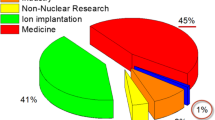Abstract
Background
Circular electron positron collider (CEPC) is a 100-km electron positron collider proposed by IHEP. The longitudinal coupled-bunch instability (LCBI) of CEPC main ring operating to study the Z particle (Z machine) may be a limiting factor of CEPC and needs to be considered seriously.
Purpose
The purposes of this paper are to calculate the LCBI caused by the fundamental mode of superconducting RF cavities in CEPC main ring, which is the most critical impedance, and to complete the design of the RF feedback systems suitable for CEPC, whose specifications can suppress the LCBI to a manageable level.
Methods
The LCBI growth rate in the CEPC main ring is calculated in the frequency domain. Two kinds of RF feedback, i.e., direct feedback and one-turn delay feedback, are simulated with the program to suppress the LCBI. And according to the suppression effect of LCBI growth rate after adding RF feedback, the required design parameters are given.
Results
Two operation conditions of Z machine have severe LCBI without suppression, and dozens of longitudinal modes are unstable. Only the direct RF feedback is needed to suppress LCBI in the case of Z-30 MW, while both the direct RF feedback with maximum gain and one-turn feedback are needed in the case of Z-50 MW. The LCBI growth rates can be reduced to the order of half frequency of the synchronous oscillation.
Conclusion
The LCBI of CEPC Z machine has been studied. Selecting appropriate feedback RF feedback can reduce the LCBI to an acceptable value that bunch by bunch feedback can suppress.









Similar content being viewed by others
References
The CEPC-SPPC Study Group, CEPC Conceptual Design Report: vol. 1 accelerator. https://doi.org/10.48550/arXiv.1811.10545
J. Gao, CEPC and SppC Status—from the completion of CDR towards TDR. Int. J. Modern Phys. A (2021). https://doi.org/10.1142/S0217751X21420057
A.W. Chao, Physics of Collective Beam Instabilities in High Energy Accelerators, Wiley Series in Beam Physics and Accelerator Technology (1993), p. 127
K.Y. Ng, Longitudinal coupled-bunch instabilities, in Physics of Intensity Dependent Beam Instabilities (World Scientific Publishing Co. Re. Ltd., 2006), pp. 311–314
P.B. Wilson, Fundamental-mode rf design in e+ e- storage ring factories, in Frontier of Partial Beams: Factories with e+ e- Rings (Springer, Berlin, 1994), pp. 293–311
A. Abbrescia et al., FCC-ee: the Lepton Collider. Eur. Phys. J. Spec. Top. 228, 261–623 (2019). https://doi.org/10.1140/epjst/e2019-900045-4
A. Drago, Feedback Systems for FCC-ee. https://doi.org/10.48550/arXiv.1704.06162
I. Karpov, E. Shaposhnikova. Longitudinal coupled-bunch instability evaluation for FCC-hh, in 10th Particle Accelerator Conference (IPAC'19), Melbourne, Australia, 19–24 May 2019 (JACOW, Geneva, Switzerland, 2019)
F. Pedersen, RF cavity feedback, CERN, Geneva, Switzerland, Rep. CERN-PS-92-59-RF, Dec (1992)
D. Boussard, Control of cavities with high beam loading. IEEE Trans. Nucl. Sci. 32(5), 1852–1856 (1985). https://doi.org/10.1109/TNS.1985.4333745
Y. Xia, A study on beam loading effects in the SSRF storage ring [D]. University of Chinese Academy of Sciences (2019)
G.F. Franklin, J.D. Powell, A. Emami-Naeini et al., in Feedback Control of Dynamic Systems, 2nd edn. (Upper Saddle River, Prentice hall, 2017), p. 6
P. Baudrenghien, T. Mastoridis, J. Molendijk, in The LHC One-Turn Feedback, CERNATS-Note-2012-025 PERF, February (2012)
P. Baudrenghien, Low level RF systems for synchrotrons: part II: high intensity, in Compensation of the Beam Induced Effects, CAS: Radio Frequency Engineering, Seeheim, Germany, 8–16 May 2000, and CERN-2005-003, p. 175
Author information
Authors and Affiliations
Corresponding author
Ethics declarations
Conflict of interest
The authors declare that they have no conflict of interest.
Rights and permissions
Springer Nature or its licensor (e.g. a society or other partner) holds exclusive rights to this article under a publishing agreement with the author(s) or other rightsholder(s); author self-archiving of the accepted manuscript version of this article is solely governed by the terms of such publishing agreement and applicable law.
About this article
Cite this article
Zhu, H., Xin, T., Zhai, J. et al. Suppression of longitudinal coupled-bunch instabilities with RF feedback systems in CEPC main ring. Radiat Detect Technol Methods 7, 210–219 (2023). https://doi.org/10.1007/s41605-023-00382-4
Received:
Revised:
Accepted:
Published:
Issue Date:
DOI: https://doi.org/10.1007/s41605-023-00382-4




